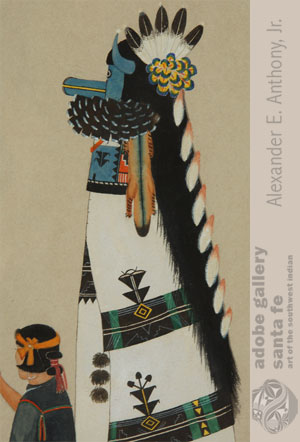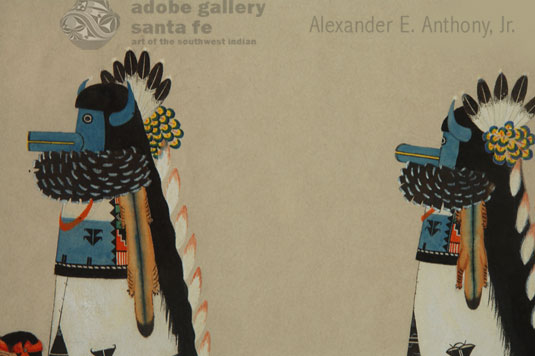Three Zuni Shalako with Attendants [R]
+ Add to my watchlist Forward to Friend
Forward to Friend
- Category: Paintings
- Origin: San Ildefonso Pueblo, Po-woh-ge-oweenge
- Medium: gouache on paper
- Size:
16” x 22-1/4” image;
25-5/8” x 31-1/2” framed - Item # C3874A
- Price No Longer Available
 Many of the early self-taught artists and those who studied at The Studio of the Santa Fe Indian School predominately painted single-figure dancers, because that was how they were taught to paint. Perhaps it was too difficult to paint long lines of dancers as they appeared in the plaza, or perhaps these simple single-figure images were less demanding for youngsters.
Many of the early self-taught artists and those who studied at The Studio of the Santa Fe Indian School predominately painted single-figure dancers, because that was how they were taught to paint. Perhaps it was too difficult to paint long lines of dancers as they appeared in the plaza, or perhaps these simple single-figure images were less demanding for youngsters.
Alfonso Roybal (1898-1955) Awa Tsireh was painting before 1917, while he was still just a teenager. He was the oldest of the early group of pueblo painters. His formal education had not extended beyond primary grades. He was versatile in his styles of painting in that he was equally comfortable with representational or semi-realistic. The majority of his early work is in the Santa Fe Indian School two-dimensional style. Most of these flat-style pieces depict single figures.
There is no doubt that Awa Tsireh attended the Zuni Shalako ceremonies at some point in his life, as did all other pueblo residents. Members of a pueblo regularly attended other pueblo functions and still do so today. That Awa Tsireh attended Shalako is evident in this painting. Most Shalako paintings by artists invariably show the Shalako, Mudheads and other participants of the ceremony in their ceremonial function. Awa Tsireh chose to paint three Shalako as they approach the Zuni Bridge from where they will begin the race that occurs on the last day of Shalako.
It has been stated that should a Shalako fall during the race, that is an omen for bad luck for the coming year.
Shalako, a reenactment of the creation and migration of the Zuni people to "Heptina," the "Middle Place," has persisted through the centuries. The religious activities are controlled by "caciques" of the six kivas, representing the four directions and up and down, which constitute the dance groups. Each kiva is associated with a direction, a color, and certain fetishes.
Each of the six kivas has a Shalako god representative. Each Shalako has two impersonators: the understudy and the "older brother." These spectacular figures stand approximately ten feet tall, the mask and costume being carried on a pole by an attendant inside the embroidered garments, which are draped around hoops.
Awa Tsireh presented an accurate portrayal of the Zuni Shalako. The costuming is accurate in detail and is a good ethnographic record of the Shalako for the future. The painting dates to the 1930s.
![]() This painting is illustrated on page 208 of Through Their Eyes—Indian Painting in Santa Fe, 1918-1945 by Michelle McGeough, Wheelwright Museum of the American Indian, 2009
This painting is illustrated on page 208 of Through Their Eyes—Indian Painting in Santa Fe, 1918-1945 by Michelle McGeough, Wheelwright Museum of the American Indian, 2009
Condition: It appears that the paper was rolled for some time before being framed as there are very slight vertical creases in the paper. They are only obvious when the painting is held at various angles so light shines on the paper.
Provenance:
- Originally from collection of Witter Bynner, famous Santa Fe poet;
From collection of Robert O. Anderson, Oil tycoon from Roswell, New Mexico and for whom the business school at the University of New Mexico was named
- Currently from the Charlotte G. Mittler collection, purchased from Owings-Dewey Fine Art in 1993
Recommended Reading: Through Their Eyes—Indian Painting in Santa Fe, 1918-1945 by Michelle McGeough, Wheelwright Museum of the American Indian, 2009

- Category: Paintings
- Origin: San Ildefonso Pueblo, Po-woh-ge-oweenge
- Medium: gouache on paper
- Size:
16” x 22-1/4” image;
25-5/8” x 31-1/2” framed - Item # C3874A
- Price No Longer Available



